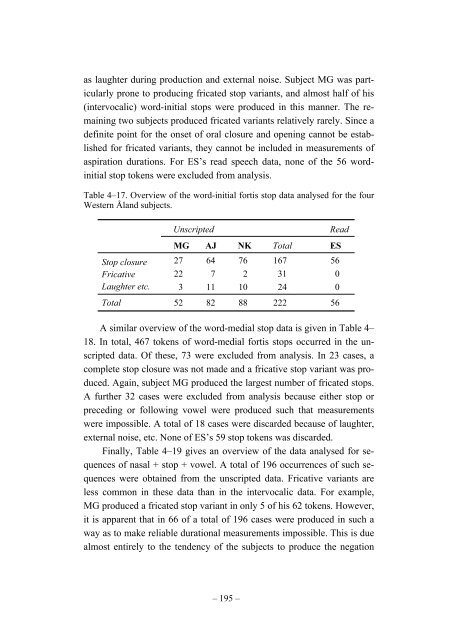Preaspiration in the Nordic Languages: Synchronic and Diachronic ...
Preaspiration in the Nordic Languages: Synchronic and Diachronic ...
Preaspiration in the Nordic Languages: Synchronic and Diachronic ...
You also want an ePaper? Increase the reach of your titles
YUMPU automatically turns print PDFs into web optimized ePapers that Google loves.
as laughter dur<strong>in</strong>g production <strong>and</strong> external noise. Subject MG was particularly<br />
prone to produc<strong>in</strong>g fricated stop variants, <strong>and</strong> almost half of his<br />
(<strong>in</strong>tervocalic) word-<strong>in</strong>itial stops were produced <strong>in</strong> this manner. The rema<strong>in</strong><strong>in</strong>g<br />
two subjects produced fricated variants relatively rarely. S<strong>in</strong>ce a<br />
def<strong>in</strong>ite po<strong>in</strong>t for <strong>the</strong> onset of oral closure <strong>and</strong> open<strong>in</strong>g cannot be established<br />
for fricated variants, <strong>the</strong>y cannot be <strong>in</strong>cluded <strong>in</strong> measurements of<br />
aspiration durations. For ES’s read speech data, none of <strong>the</strong> 56 word<strong>in</strong>itial<br />
stop tokens were excluded from analysis.<br />
Table 4–17. Overview of <strong>the</strong> word-<strong>in</strong>itial fortis stop data analysed for <strong>the</strong> four<br />
Western Ål<strong>and</strong> subjects.<br />
Unscripted Read<br />
MG AJ NK Total ES<br />
Stop closure 27 64 76 167 56<br />
Fricative 22 7 2 31 0<br />
Laughter etc. 3 11 10 24 0<br />
Total 52 82 88 222 56<br />
A similar overview of <strong>the</strong> word-medial stop data is given <strong>in</strong> Table 4–<br />
18. In total, 467 tokens of word-medial fortis stops occurred <strong>in</strong> <strong>the</strong> unscripted<br />
data. Of <strong>the</strong>se, 73 were excluded from analysis. In 23 cases, a<br />
complete stop closure was not made <strong>and</strong> a fricative stop variant was produced.<br />
Aga<strong>in</strong>, subject MG produced <strong>the</strong> largest number of fricated stops.<br />
A fur<strong>the</strong>r 32 cases were excluded from analysis because ei<strong>the</strong>r stop or<br />
preced<strong>in</strong>g or follow<strong>in</strong>g vowel were produced such that measurements<br />
were impossible. A total of 18 cases were discarded because of laughter,<br />
external noise, etc. None of ES’s 59 stop tokens was discarded.<br />
F<strong>in</strong>ally, Table 4–19 gives an overview of <strong>the</strong> data analysed for sequences<br />
of nasal + stop + vowel. A total of 196 occurrences of such sequences<br />
were obta<strong>in</strong>ed from <strong>the</strong> unscripted data. Fricative variants are<br />
less common <strong>in</strong> <strong>the</strong>se data than <strong>in</strong> <strong>the</strong> <strong>in</strong>tervocalic data. For example,<br />
MG produced a fricated stop variant <strong>in</strong> only 5 of his 62 tokens. However,<br />
it is apparent that <strong>in</strong> 66 of a total of 196 cases were produced <strong>in</strong> such a<br />
way as to make reliable durational measurements impossible. This is due<br />
almost entirely to <strong>the</strong> tendency of <strong>the</strong> subjects to produce <strong>the</strong> negation<br />
– 195 –

















